Optimization of Energy Consumption in Oil Fields Using Data Analysis
Abstract
:1. Introduction
2. Method
3. Results and Discussion
3.1. Beam Pump System
3.1.1. Impact of Daily Production on the Normalized Consumption Factor
3.1.2. Impact of Gas–Oil Ratio (GOR) on Normalized Consumption Factor
3.1.3. Impact of Well Angle on the Normalized Consumption Factor
3.2. Progressive Cavity Pump System
3.3. Electric Submersible Pump (ESP) System
4. Conclusions
- (1)
- The normalized consumption factor was utilized as a metric to assess energy consumption.
- (2)
- Higher production was found to correlate with a lower normalized consumption factor for beam pumps, progressive cavity pumps, and ESP systems.
- (3)
- A higher gas–oil ratio (GOR) was associated with a lower normalized consumption factor for the beam pump system.
- (4)
- The well angle was observed to have no significant relationship with the normalized consumption factor in the beam pump system.
- (5)
- Of the 45,000 wells in the database, the wells using beam pumps account for the vast majority, followed by progressive cavity pumps, and the least frequent use is electric submersible pumps.
- (6)
- Compared with beam pumps and progressive cavity pumps, the daily production of electric submersible pumps is the highest, between 100 and 500 t/d, while the daily production of beam pumps and progressive cavity pumps is mainly concentrated between 0 and 20 t/d.
- (7)
- Among the three oil production systems, the well depth of the beam pump system has the largest application range, which is between 0–3500 m, followed by the electric submersible pump system, and the smallest application range of well depth is the progressive cavity pump system, mainly concentrated in the range of 300–1200 m.
Author Contributions
Funding
Data Availability Statement
Conflicts of Interest
Nomenclature
| Cn | the normalized consumption factor, kW·h/(t·100 m) |
| PE | the useful input power, kW |
| P′ | the effective input power, kW |
| T | the time, h |
| Q | the liquid production, t/d |
| H | the pump depth, m |
| η | the system efficiency, % |
References
- Ramos, A.J.A.; Júnior, D.S.A.; Santos, A.R.; Araújo, E.A.; Aum, P.T.P. Energy dissipation analysis of oil wells sucker rod string. J. Braz. Soc. Mech. Sci. Eng. 2020, 42, 108. [Google Scholar] [CrossRef]
- Filho, J.C.V.H.; Schiozer, D.J. Effect of reservoir and production system integration on field production strategy selection. Oil Gas Sci. Technol. Rev. IFP Energ. Nouv. 2018, 73, 44. [Google Scholar] [CrossRef]
- Bello, O.; Dolberg, E.P.; Teodoriu, C.; Karami, H.; Devegowdva, D. Transformation of academic teaching and research: Development of a highly automated experimental sucker rod pumping unit. J. Pet. Sci. Eng. 2020, 190, 107087. [Google Scholar] [CrossRef]
- Cotrim, H.A.; von Hohendorff Filho, J.C.; Schiozer, D.J. Production Optimization Considering Interaction between Reservoirs and Constrained Surface Facilities. In Proceedings of the SPE Reservoir Characterisation and Simulation Conference and Exhibition, Abu Dhabi, United Arab Emirates, 9–11 October 2011; Society of Petroleum Engineers: Richardson, TX, USA. [Google Scholar] [CrossRef]
- Garrouch, A.A.; Al-Dousari, M.M.; Al-Sarraf, Z. A pragmatic approach for optimizing gas lift operations. J. Pet. Explor. Prod. Technol. 2020, 10, 197–216. [Google Scholar] [CrossRef]
- Shi, J.; Al-Durra, A.; Boiko, I. Optimal tracking control of artificial gas-lift process. Comput. Chem. Eng. 2018, 117, 1–10. [Google Scholar] [CrossRef]
- Cortes, B.; Araujo, L.R.; Penido, D.R.R. Electrical submersible pump system model to assist oil lifting studies. J. Pet. Sci. Eng. 2019, 174, 1279–1289. [Google Scholar] [CrossRef]
- Takacs, G. Sucker-Rod Pumping System Components and Their Operation. In Sucker-Rod Pumping Handbook; Elsevier: Amsterdam, The Netherlands, 2015; pp. 57–246. [Google Scholar] [CrossRef]
- Uetani, T.; Furuichi, N.; Yorozu, H.; Sasaya, K.; Shibuya, T.; Kiminami, N.; Yonebayashi, H. Regaining Oil Production by Overcoming Emulsion Problems After Artificial Lift Installation. SPE Prod. Oper. 2018, 33, 300–312. [Google Scholar] [CrossRef]
- Shi, J.; Chen, S.; Zhang, X.; Zhao, R.; Liu, Z.; Liu, M.; Zhang, N.; Sun, D. Artificial Lift Methods Optimising and Selecting Based on Big Data Analysis Technology. In Proceedings of the 11th International Petroleum Technology Conference, Beijing, China, 26–28 March 2019. [Google Scholar] [CrossRef]
- Yu, J.; Wen, Z.; Geng, L. An Effective Experience on Reducing the Power Consumption and Produced Water Drainage of Boxi Oilfields. In Proceedings of the International Oil and Gas Conference and Exhibition in China, Beijing, China, 8–10 June 2010; Society of Petroleum Engineers: Richardson, TX, USA. [Google Scholar] [CrossRef]
- Zhao, R.; Zhang, X.; Liu, M.; Shi, J.; Su, L.; Shan, H.; Sun, C.; Miao, G.; Wang, Y.; Shi, L.; et al. Production Optimizaton and Application of Combined Artificial-Lift Systems in Deep Oil Wells. In Proceedings of the SPE Middle East Artificial Lift Conference and Exhibition, Manama, Bahrain, 30 November–1 December 2016; Society of Petroleum Engineers: Richardson, TX, USA. [Google Scholar] [CrossRef]
- Zhao, R.; Shi, J.; Zhang, X.; Li, J.; Peng, Y.; Xiong, C.; Liu, M.; Deng, F.; Song, S.; Miao, G. Research and Application of the Big Data Analysis Platform of Oil and Gas Production. In Proceedings of the International Petroleum Technology Conference, Beijing, China, 26–28 March 2019; Society of Petroleum Engineers: Richardson, TX, USA. [Google Scholar] [CrossRef]
- Tian, Y.; Tian, Y.; Qu, Z.; Guo, T.; Shi, Y.; Zhang, L. A new experimental simulation method for the development of non-renewable hydrogen energy—Oil and gas resources. Int. J. Hydrogen Energy 2019, 44, 5220–5229. [Google Scholar] [CrossRef]
- Davarpanah, A.; Mirshekari, B. A simulation study to control the oil production rate of oil-rim reservoir under different injectivity scenarios. Energy Rep. 2018, 4, 664–670. [Google Scholar] [CrossRef]
- Davarpanah, A.; Mirshekari, B. Effect of formate fluids on the shale stabilization of shale layers. Energy Rep. 2019, 5, 987–992. [Google Scholar] [CrossRef]
- Lei, Q.; Zhang, F.; Guan, B.; Liu, G.; Li, X.; Zhu, Z. Influence of shear on rheology of the crude oil treated by flow improver. Energy Rep. 2019, 5, 1156–1162. [Google Scholar] [CrossRef]
- Wang, H.; Ran, Q.; Liao, X. Pressure transient responses study on the hydraulic volume fracturing vertical well in stress-sensitive tight hydrocarbon reservoirs. Int. J. Hydrogen Energy 2017, 42, 18343–18349. [Google Scholar] [CrossRef]
- Zhang, X.; Shi, J.; Zhao, R.; Deng, F.; Li, Q.; Zhang, J.; Sun, C.; Miao, G.; Song, S. Research and Application of Overall Energy Consumption Optimization Technology Under Low Oil Price. In Proceedings of the SPE Middle East Artificial Lift Conference and Exhibition, Manama, Bahrain, 28–29 November 2018; Society of Petroleum Engineers: Richardson, TX, USA. [Google Scholar] [CrossRef]
- Li, H.; He, J.; Misra, S. Data-Driven In-Situ Geomechanical Characterization in Shale Reservoirs. In Proceedings of the SPE Annual Technical Conference and Exhibition, Dallas, TX, USA, 24–26 September 2018; Society of Petroleum Engineers: Richardson, TX, USA. [Google Scholar] [CrossRef]
- Li, H.; Misra, S. Assessment of miscible light-hydrocarbon-injection recovery efficiency in Bakken shale formation using wireline-log-derived indices. Mar. Pet. Geol. 2018, 89, 585–593. [Google Scholar] [CrossRef]
- Liang, X.; Zhou, F.; Liang, T.; Su, H.; Yuan, S.; Li, Y. Impacts of pore structure and wettability on distribution of residual fossil hydrogen energy after imbibition. Int. J. Hydrogen Energy 2020, 45, 14779–14789. [Google Scholar] [CrossRef]
- Ghareeb, M.; Shedid, S.A.; Ibrahim, M. Simulation Investigations for Enhanced Performance of Beam Pumping System for Deep High Volume Wells. In Proceedings of the International Oil Conference and Exhibition in Mexico, Veracruz, Mexico, 27–30 June 2007; Society of Petroleum Engineers: Richardson, TX, USA. [Google Scholar] [CrossRef]
- Liu, X.; Qi, Y. A modern approach to the selection of sucker rod pumping systems in CBM wells. J. Pet. Sci. Eng. 2011, 76, 100–108. [Google Scholar] [CrossRef]
- Xing, M.; Dong, S. A New Simulation Model for a Beam-Pumping System Applied in Energy Saving and Resource-Consumption Reduction. SPE Prod. Oper. 2015, 30, 130–140. [Google Scholar] [CrossRef]
- Tian, Y.; Qu, Z.; Guo, T.; Tian, Y. Theoretical research on radial wells orientating hydraulically created fracture directional extended. Int. J. Hydrogen Energy 2017, 42, 18358–18363. [Google Scholar] [CrossRef]
- Alemi, M.; Jalalifar, H.; Kamali, G.R.; Kalbasi, M. A mathematical estimation for artificial lift systems selection based on ELECTRE model. J. Pet. Sci. Eng. 2011, 78, 193–200. [Google Scholar] [CrossRef]
- Xu, J.; Li, J.; Chen, J.; Han, M.; Han, X.; Li, J. Research on Power Saving Positive Torque and Constant Power Pumping Unit and Tracking Technique System. Procedia Eng. 2012, 29, 1034–1041. [Google Scholar] [CrossRef]
- Zheng, D.; Miska, S.; Ozbayoglu, E.; Zhang, J. Combined Experimental and Well Log Study of Anisotropic Strength of Shale. In Proceedings of the SPE Annual Technical Conference and Exhibition, San Antonio, TX, USA, 16–18 October 2023; p. D031S046R003. [Google Scholar]
- Garces, W.A.Z.; Rodriguez, G.M. Power Consumption Measurements & Optimization Automated with Null Electrical Risk in Esp Systems. In Proceedings of the SPE Middle East Artificial Lift Conference and Exhibition, Manama, Bahrain, 28–29 November 2018; Society of Petroleum Engineers: Richardson, TX, USA. [Google Scholar] [CrossRef]
- Almukhtar, M.A.; Alabdulmohsin, Y.A.; Shawly, A.S.; Shehri, A.M.; Shammari, N.S.; Al-kuhlani, M. Innovative Approach to Optimize ESP Power Consumption through Developed Software. In Proceedings of the SPE Kingdom of Saudi Arabia Annual Technical Symposium and Exhibition, Dammam, Saudi Arabia, 24–27 April 2017; Society of Petroleum Engineers: Richardson, TX, USA. [Google Scholar] [CrossRef]
- Sanchez, J.P.; Bel, O.; Festini, D. Beam Pumping System Optimization Through Automation. In Proceedings of the Latin American & Caribbean Petroleum Engineering Conference, Buenos Aires, Argentina, 15–18 April 2007; Society of Petroleum Engineers: Richardson, TX, USA. [Google Scholar] [CrossRef]
- Shi, J.; Han, Q.; Ren, X.; Zhang, X.; Zhao, R.; Chen, S.; Li, Q.; Zheng, X. The Application of Big Data Analysis in the Optimizing and Selecting Artificial Lift Methods. In Proceedings of the SPE Middle East Artificial Lift Conference and Exhibition, Manama, Bahrain, 28–29 November 2018; Society of Petroleum Engineers: Richardson, TX, USA. [Google Scholar] [CrossRef]
- Zheng, D.; Miska, S.; Ziaja, M.; Zhang, J. Study of anisotropic strength properties of shale. AGH Drill. Oil Gas 2019, 36, 93–112. [Google Scholar] [CrossRef]
- Wang, F.; He, L.; Wanfu, Z.; Guochen, S.; Gang, C.; Ruiqing, C.; Deshi, Z.; Dingming, L. Application of Beam Pumping Wells’s; Energy Saving Rebuilding Techniques in Daqing Oilfield. In Proceedings of the SPE Annual Technical Conference and Exhibition, New Orleans, LA, USA, 4–7 October 2009; Society of Petroleum Engineers: Richardson, TX, USA. [Google Scholar] [CrossRef]
- Zheng, D.; Ozbayoglu, E.; Miska, S.; Zhang, J. Experimental Study of Anisotropic Strength Properties of Shale. In Proceedings of the ARMA 23241 at the 57th US Rock Mechanics/Geomechanics Symposium, Atlanta, GA, USA, 25–28 June 2023. [Google Scholar]
- Kindi, M.; Ghadani, A.; Shekaili, S.; Aufi, F.; Al Wahaibi, S.; Gomez, C.M. Revolutionizing Oil Lift Operations: Harnessing Data Analytics for Esp Energy Management, Cost Savings, CO2 Emissions Reduction, and Enhanced Pump Runlife. In Proceedings of the International Petroleum Technology Conference, Dhahran, Saudi Arabia, 12 February 2024. [Google Scholar] [CrossRef]
- Denesha, D.P. Reducing Power Consumption in Rod Pumped Wells: A Digital Approach. In Proceedings of the SPE California Regional Meeting, Bakersfield, CA, USA, 27–29 March 1985; Society of Petroleum Engineers: Richardson, TX, USA. [Google Scholar] [CrossRef]
- Kochtik, D.; Langbauer, C. Volumetric Efficiency Evaluation of Sucker-Rod-Pumping Applications Performed on a Pump Testing Facility. In Proceedings of the SPE Middle East Artificial Lift Conference and Exhibition, Manama, Bahrain, 28–29 November 2018; Society of Petroleum Engineers: Richardson, TX, USA. [Google Scholar] [CrossRef]
- Hadzihafizovic, D. Production Operations in Oilfield. 2023, p. 54. Available online: https://zenodo.org/records/10338730 (accessed on 14 February 2024).
- Wang, Y.; Wang, S.; Yang, L.; Pu, H.; Ling, K. A New Model to Evaluate Polished Rod Load of Sucker Rod Pumping System. In Proceedings of the SPE Liquids-Rich Basins Conference—North America, Midland, TX, USA, 5–6 September 2018; Society of Petroleum Engineers: Richardson, TX, USA. [Google Scholar] [CrossRef]
- Gao, C.H.; Rajeswaran, R.T.; Nakagawa, E.Y. A Literature Review on Smart Well Technology. In Proceedings of the Production and Operations Symposium, Oklahoma City, OK, USA, 31 March–3 April 2007; Society of Petroleum Engineers: Richardson, TX, USA. [Google Scholar] [CrossRef]
- Worth, D.; Al-Safran, E.; Choudhuri, A.; Al-Jasmi, A. Assessment of artificial lift methods for a heavy oil field in Kuwait. J. Pet. Sci. Eng. 2019, 180, 835–843. [Google Scholar] [CrossRef]
- Valdés, J.P.; Becerra, D.; Rozo, D.; Cediel, A.; Torres, F.; Asuaje, M.; Ratkovich, N. Comparative analysis of an electrical submersible pump’s performance handling viscous Newtonian and non-Newtonian fluids through experimental and CFD approaches. J. Pet. Sci. Eng. 2020, 187, 106749. [Google Scholar] [CrossRef]
- Ricardo, D.M.M.; Jiménez, G.E.C.; Ferreira, J.V.; Meirelles, P.S. Multiphase gas-flow model of an electrical submersible pump. Oil Gas Sci. Technol. Rev. IFP Energ. Nouv. 2018, 73, 29. [Google Scholar] [CrossRef]
- Gaspar, A.T.F.S.; Barreto, C.E.A.G.; Mazo, E.O.M.; Schiozer, D.J. Application of Assisted Optimization to Aid Oil Exploitation Strategy Selection for Offshore Fields. In Proceedings of the SPE Latin America and Caribbean Petroleum Engineering Conference, Maracaibo, Venezuela, 21–23 May 2014; Society of Petroleum Engineers: Richardson, TX, USA. [Google Scholar] [CrossRef]
- Bai, C.; Zheng, D.; Hure, R.; Saleh, R.; Carvajal, N.; Morrison, G. The Impact of Journal Bearing Wear on an Electric Submersible Pump in Two-Phase and Three-Phase Flow. J. Tribol. 2019, 141, 051702. [Google Scholar] [CrossRef]
- von Hollen, D.G.; Newton, S.K. Pumping Unit Optimization. In Proceedings of the SPE Latin America/Caribbean Petroleum Engineering Conference, Port of Spain, Trinidad and Tobago, 23–26 April 1996; Society of Petroleum Engineers: Richardson, TX, USA. [Google Scholar] [CrossRef]
- Liang, X.; Zhou, F.; Liang, T. A New Intermittent Pumping Design for Fluid Shortage Wells. Sci. Rep. 2020, 10, 2559. [Google Scholar] [CrossRef] [PubMed]
- Rafieepour, S.; Zheng, D.; Miska, S.; Ozbayoglu, E.; Takach, E. Combined Experimental and Well Log Evaluation of Anisotropic Mechanical Properties of Shales: An Application to Wellbore Stability in Bakken Formation. In Proceedings of the SPE Annual Technical Conference and Exhibition, Virtual, 26–29 October 2020. [Google Scholar]
- Moriarty, D.G.; Renard, D.P. Proper Operation of Pumping Units Reduce Lifting Costs. In Proceedings of the SPE Production Operations Symposium, Oklahoma City, OK, USA, 27 February–1 March 1983; Society of Petroleum Engineers: Richardson, TX, USA. [Google Scholar] [CrossRef]
- Caicedo, M.R.; Varela, S.; Beatriz, D.; Herrera, J.F. Operational Cost Saving Through Artificial Lift Optimization With Long Stroke Pumping Units in Fields of Cravo Viejo Block. In Proceedings of the SPE Artificial Lift Conference-Americas, Cartagena, Colombia, 21–22 May 2013; Society of Petroleum Engineers: Richardson, TX, USA. [Google Scholar] [CrossRef]
- Tigrero, H.; Lainez, C.; Salinas, M. Pull & Push. Usage of the Mechanical Energy of a Conventional Sucker Rod Lift in Shallow Wells. In Proceedings of the SPE Latin American and Caribbean Petroleum Engineering Conference, Quito, Ecuador, 18–20 November 2015; Society of Petroleum Engineers: Richardson, TX, USA. [Google Scholar] [CrossRef]
- Zheng, D.; Turhan, C.; Wang, N.; Ashok, P.; van Oort, E. Prioritizing Wells for Repurposing or Permanent Abandonment Based on Generalized Well Integrity Risk Analysis. In Proceedings of the SPE/IADC Drilling Conference and Exhibition, Galveston, TX, USA, 5–7 March 2024; p. D021S018R001. [Google Scholar]
- Byrd, J.P.; Beasley, H.L. Predicting Prime Mover Requirements, Power Costs, and Electrical Demand for Beam Pumping Units. In Proceedings of the Annual Technical Meeting, Calgary, Alberta, 6–9 May 1974; Society of Petroleum Engineers: Richardson, TX, USA. [Google Scholar] [CrossRef]
- Skinner, D.R. Efficient Use of Electric Power in Production Operations. J. Pet. Technol. 1984, 36, 1326–1334. [Google Scholar] [CrossRef]
- Zheng, D. Geological Analysis and Cement Composition for Improving Zonal Isolation. Ph.D. Thesis, The University of Tulsa, Tulsa, OK, USA, 2023. [Google Scholar]
- Brandt, J.U.; Lewerenz, J.; Mueller-Link, D.; Reichwage, M. Development of a Multiphase Down-hole Twin-screw Pump and its Use in Multiphase-operated Transport Networks. Oil Gas Eur. Mag. 2015, 41, 153–156. [Google Scholar]
- Zheng, D.; Ozbayoglu, E.; Miska, S.; Liu, Y. Cement Sheath Fatigue Failure Prediction by ANN-Based Model. In Proceedings of the Offshore Technology Conference, Houston, TX, USA, 2–5 May 2022. [Google Scholar] [CrossRef]
- Zheng, D.; Miska, S.; Ozbayoglu, E. The Influence of Formation Creeping on Wellbore Integrity. In Proceedings of the SPE 2021 Symposium Compilation, Virtual, 26 November 2021. [Google Scholar]
- Zheng, D.; Miska, S.; Ozbayoglu, E.; Zhang, Y. The Influence of Elliptical-Geometry Wellbore on Zonal Isolation. In Proceedings of the 56th U.S. Rock Mechanics/Geomechanics Symposium, Santa Fe, NM, USA, 26–29 June 2022. [Google Scholar]
- Zheng, D.; Ozbayoglu, E.; Miska, S.; Liu, Y. Cement Sheath Fatigue Failure Prediction by Support Vector Machine Based Model. In Proceedings of the SPE Eastern Regional Meeting, Wheeling, WV, USA, 18–20 October 2022. [Google Scholar]
- Zheng, D.; Ozbayoglu, E.; Baldino, S.; Miska, S.; Liu, Y. The Influence of Casing Eccentricity on Zonal Isolation. In Proceedings of the ARMA 23241 at the 57th US Rock Mechanics/Geomechanics Symposium, Atlanta, GA, USA, 25–28 June 2023. [Google Scholar]
- Mueller-Link, D.; Rohlfing, G.; Spelter, H. Twin-Screw Pumps Help Improving Oil Recovery in Mature Fields and Transfer Heavy Crude Oil over Long Distances. Oil Gas Eur. Mag. 2009, 35, 127–131. [Google Scholar]
- Guo, S.; Zheng, D.; Chen, T. Controlling the hydration rate of alkali-activated slag by the slow release of NaOH. Geoenergy Sci. Eng. 2023, 228, 211960. [Google Scholar] [CrossRef]
- Mazzola, R.; Colla, M.; Teodoulou, M.; Ballarini, M.; Pereyra, M.; Muñoz, H.; Bruni, M.; Teves, R.; Oyarzun, R. Study To Improve Energy Efficiency Using ESP. In Proceedings of the SPE Artificial Lift Conference—Latin America and Caribbean, Salvador, Bahia, Brazil, 27–28 May 2015; Society of Petroleum Engineers: Richardson, TX, USA. [Google Scholar] [CrossRef]
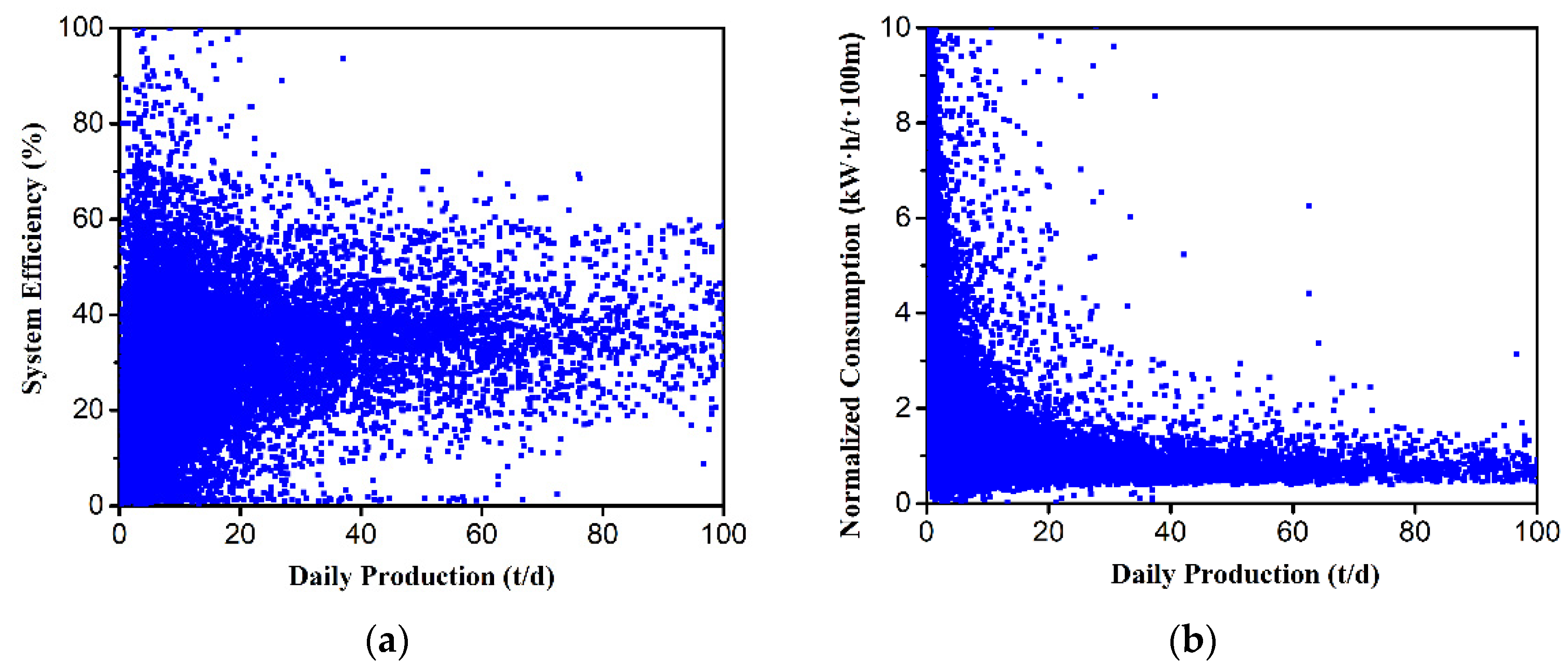
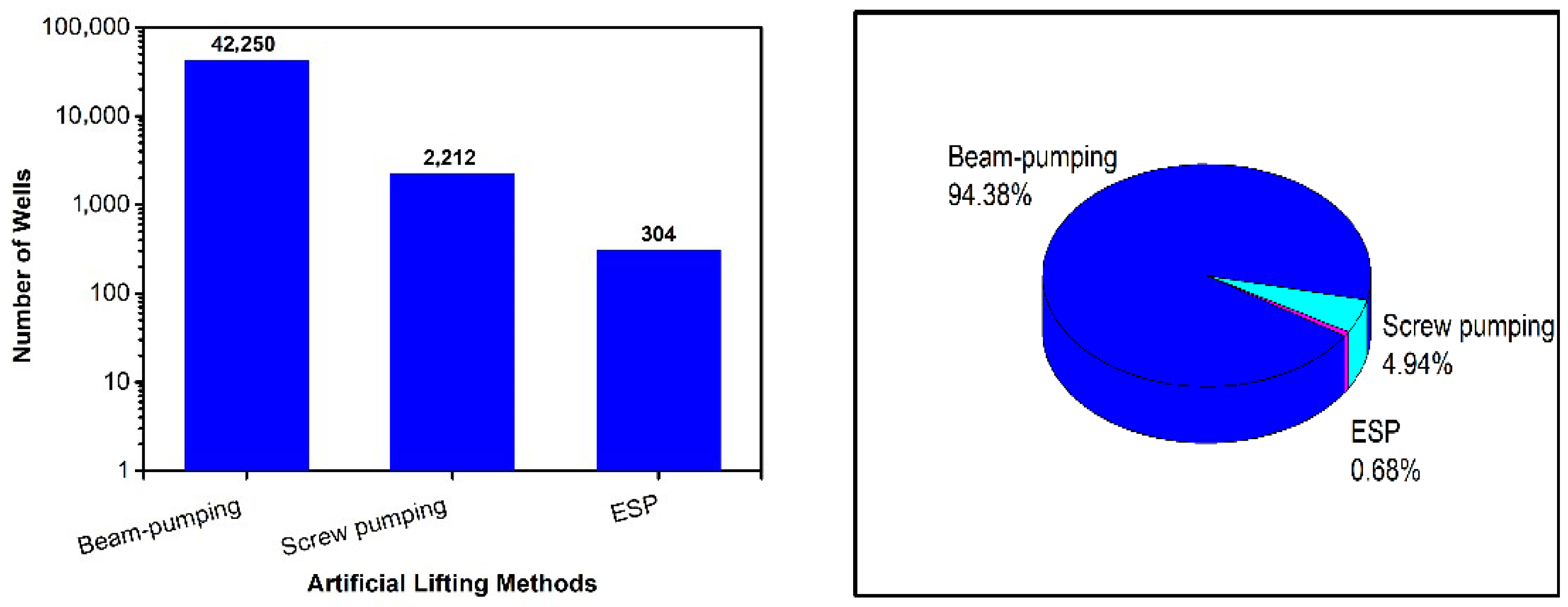
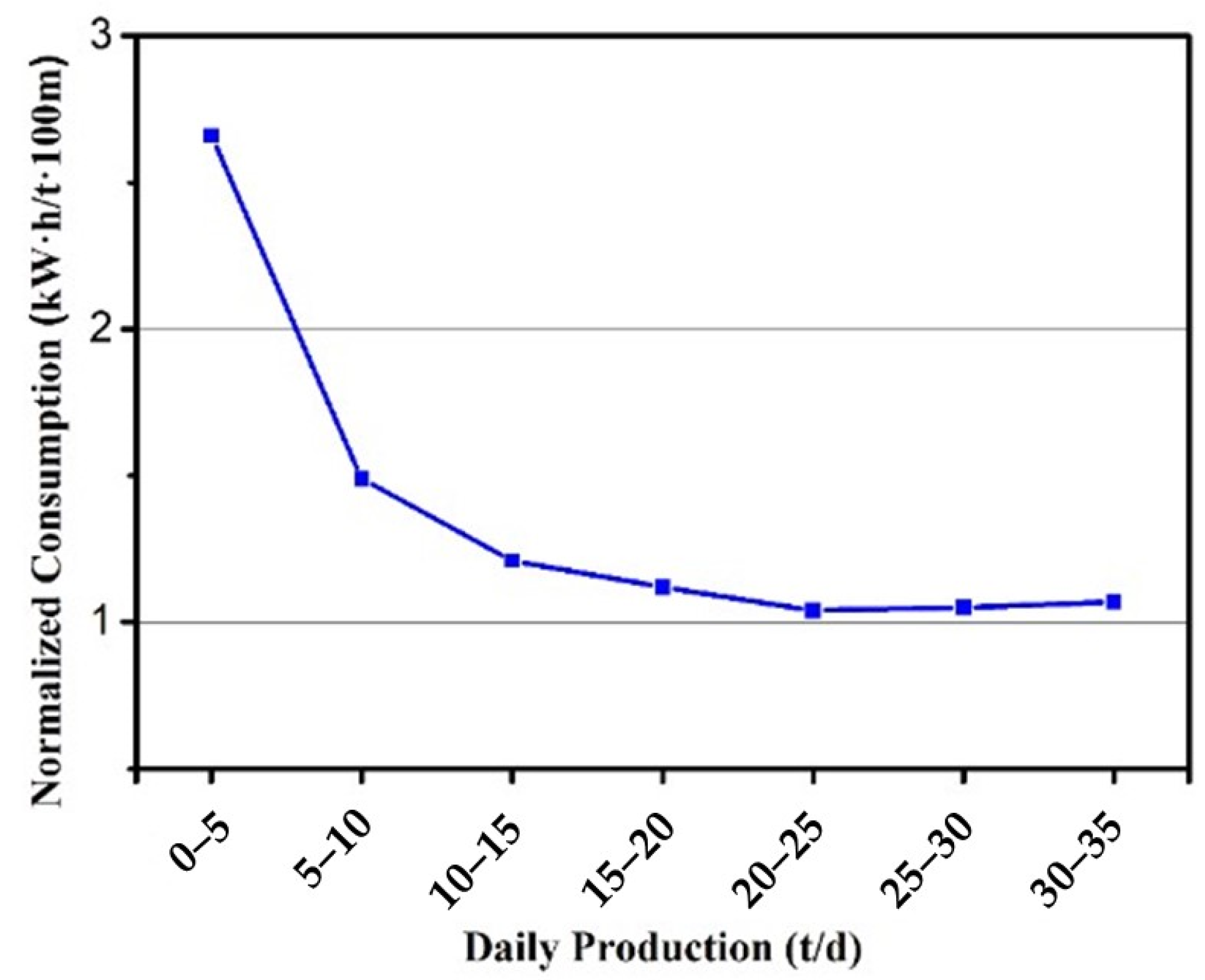

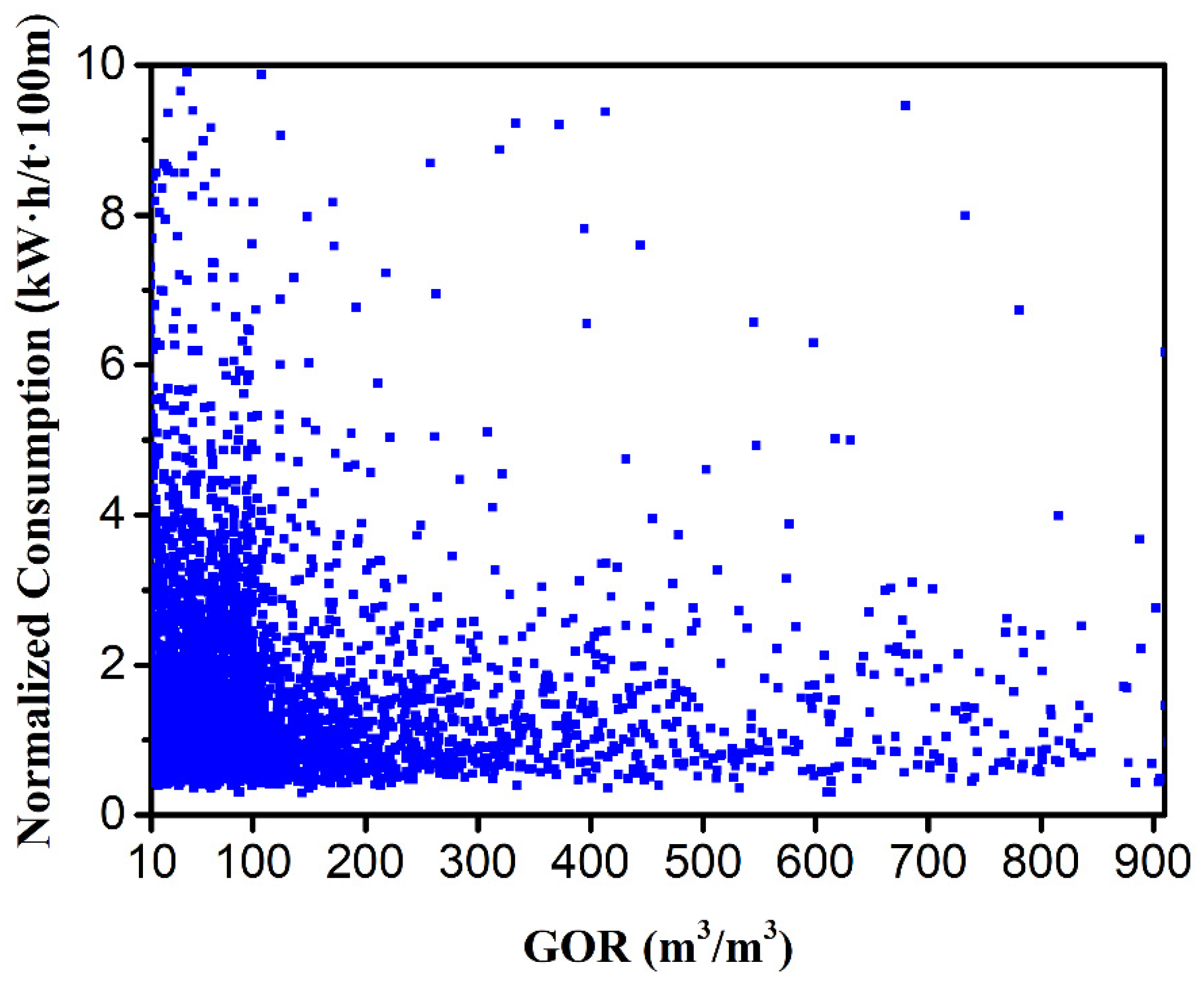


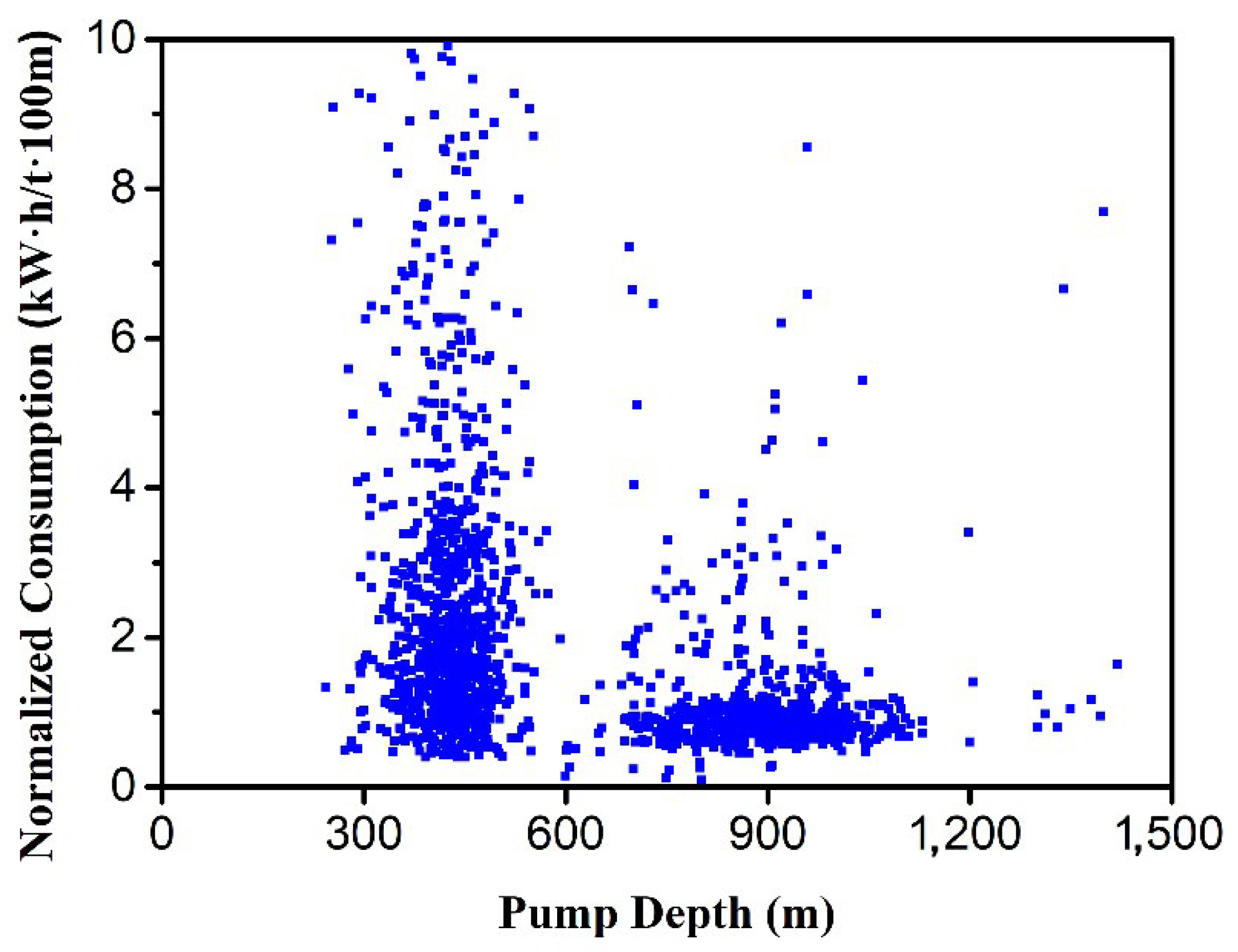

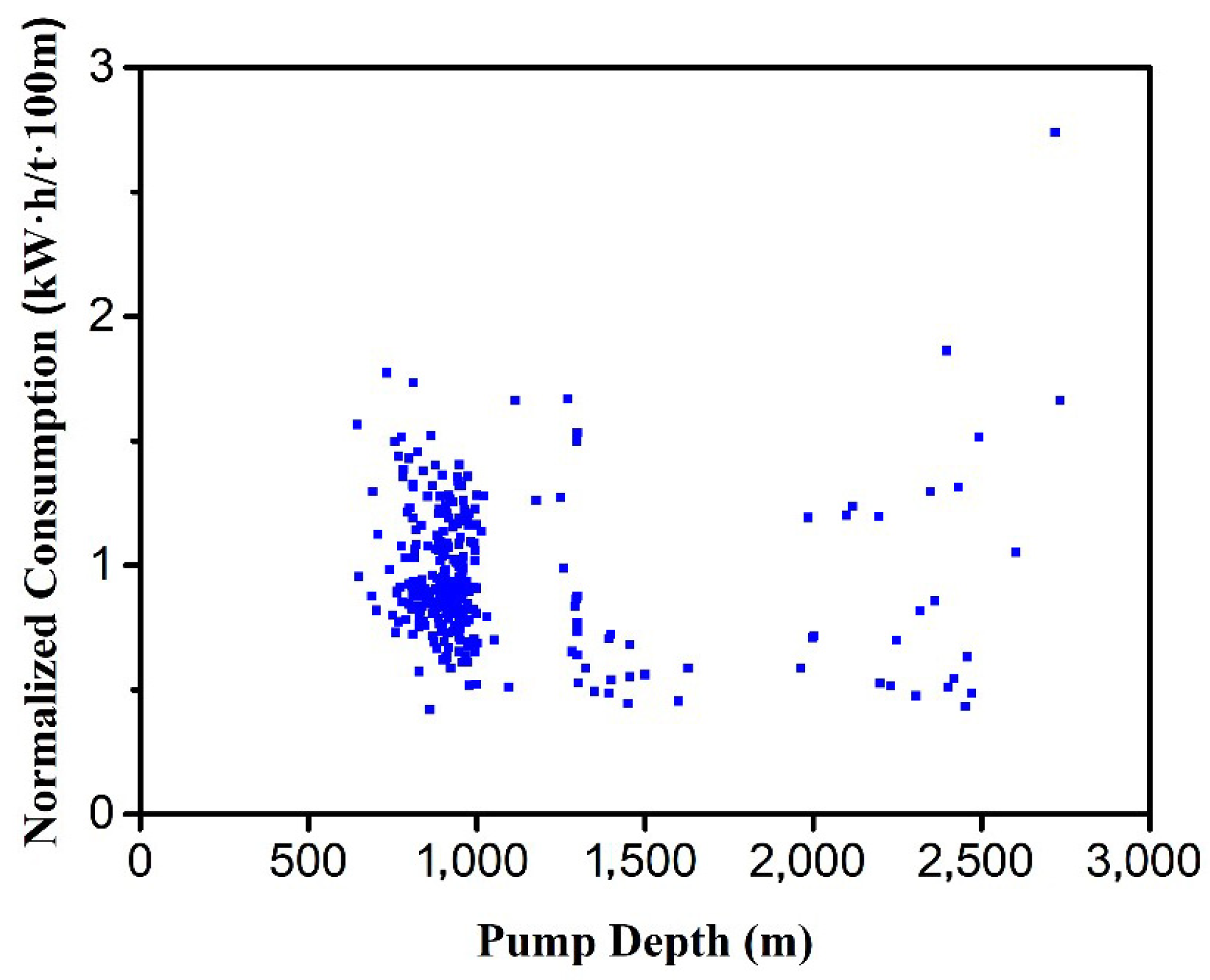
Disclaimer/Publisher’s Note: The statements, opinions and data contained in all publications are solely those of the individual author(s) and contributor(s) and not of MDPI and/or the editor(s). MDPI and/or the editor(s) disclaim responsibility for any injury to people or property resulting from any ideas, methods, instructions or products referred to in the content. |
© 2024 by the authors. Licensee MDPI, Basel, Switzerland. This article is an open access article distributed under the terms and conditions of the Creative Commons Attribution (CC BY) license (https://creativecommons.org/licenses/by/4.0/).
Share and Cite
Liang, X.; Xing, Z.; Yue, Z.; Ma, H.; Shu, J.; Han, G. Optimization of Energy Consumption in Oil Fields Using Data Analysis. Processes 2024, 12, 1090. https://doi.org/10.3390/pr12061090
Liang X, Xing Z, Yue Z, Ma H, Shu J, Han G. Optimization of Energy Consumption in Oil Fields Using Data Analysis. Processes. 2024; 12(6):1090. https://doi.org/10.3390/pr12061090
Chicago/Turabian StyleLiang, Xingyuan, Zhisheng Xing, Zhenduo Yue, He Ma, Jin Shu, and Guoqing Han. 2024. "Optimization of Energy Consumption in Oil Fields Using Data Analysis" Processes 12, no. 6: 1090. https://doi.org/10.3390/pr12061090







